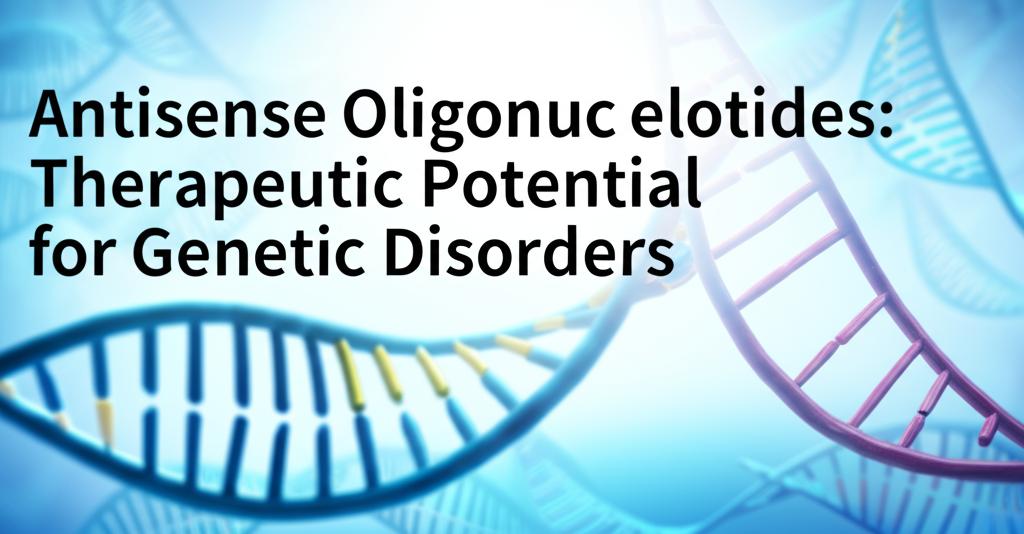Antisense oligonucleotides (ASOs) represent a cutting-edge therapeutic approach offering precise control over gene expression by targeting RNA molecules, the messengers that carry genetic instructions to the protein-making machinery of cells. Unlike traditional drugs that often target proteins, ASOs can intervene earlier in the process, potentially modifying or halting disease progression at a more fundamental level. These short, synthetic, single-stranded nucleic acid chains are designed to bind to specific RNA sequences through complementary base pairing.
ASOs employ several mechanisms to modulate gene expression depending on their design and chemical modifications. Some ASOs trigger the degradation of target messenger RNA (mRNA) using the cellular enzyme RNase H, effectively silencing the production of a specific, often harmful, protein. Others work through steric hindrance, physically blocking the cellular machinery involved in RNA processing or translation. This can be used to modulate pre-mRNA splicing – correcting splicing defects to restore the production of functional proteins or skipping certain exons to bypass disease-causing mutations.
The therapeutic potential for genetic disorders is significant, as many of these conditions stem from errors in single genes leading to dysfunctional proteins or abnormal levels of protein expression. Because ASOs can be designed to target virtually any RNA sequence, they offer a highly specific way to address the underlying genetic cause of disease.
Several ASO therapies have already gained regulatory approval and demonstrated success in treating previously challenging genetic conditions:
- Spinal Muscular Atrophy (SMA): Nusinersen (Spinraza) modifies the splicing of the SMN2 gene to increase the production of functional Survival Motor Neuron (SMN) protein, crucial for motor neuron health.
- Duchenne Muscular Dystrophy (DMD): A group of ASOs, including Eteplirsen (Exondys 51), Golodirsen (Vyondys 53), Viltolarsen (Viltepso), and Casimersen (Amondys 45), promote the skipping of specific exons in the dystrophin gene's pre-mRNA, allowing for the production of a shortened but partially functional dystrophin protein.
- Hereditary Transthyretin-mediated Amyloidosis (hATTR): Inotersen (Tegsedi) and Eplonersen work by reducing the production of the faulty transthyretin (TTR) protein, preventing its harmful accumulation in tissues.
- Amyotrophic Lateral Sclerosis (ALS): Tofersen (Qalsody) targets the mRNA produced from mutated SOD1 genes, reducing the production of the toxic SOD1 protein implicated in some forms of familial ALS.
- Familial Chylomicronemia Syndrome (FCS): Olezarsen (Tryngolza), approved in late 2024, decreases the liver's production of apoC-III protein to manage severely high triglyceride levels characteristic of this rare genetic disorder.
Despite these successes, developing ASO therapies presents challenges. Naked ASOs can be susceptible to degradation by enzymes in the body and may struggle to efficiently cross cell membranes or reach specific tissues, particularly the brain. To overcome these hurdles, ASOs undergo extensive chemical modifications. Changes to the sugar-phosphate backbone (like phosphorothioate linkages) and the ribose sugar (such as 2'-O-methoxyethyl or 'MOE' modifications) enhance stability against degradation, increase binding affinity to target RNA, improve pharmacokinetic properties, and reduce potential immune responses.
Innovations in delivery systems are also crucial. Strategies include conjugation to specific molecules (like GalNAc sugars for liver targeting or antibodies/peptides for specific cell types) and encapsulation within nanoparticles (e.g., lipid nanoparticles) or exosomes to improve tissue penetration, cellular uptake, and escape from cellular compartments that might otherwise trap the drug. Direct administration into specific sites, like intrathecal injection into the cerebrospinal fluid for neurological disorders, bypasses systemic barriers like the blood-brain barrier.
The field is rapidly evolving, moving towards increasingly personalized treatments. ASOs can be custom-designed to target unique mutations found only in small groups of patients or even single individuals (n-of-1 therapies), offering hope for those with ultra-rare genetic conditions previously deemed untreatable. Ongoing research and clinical trials are exploring ASO applications for a wider range of genetic disorders, including Huntington's disease, spinocerebellar ataxias, and conditions like Alzheimer's disease where specific gene expression contributes to pathology.
As chemical modifications become more sophisticated and delivery methods more targeted and efficient, ASOs are poised to become a cornerstone of precision medicine. Their ability to directly address the genetic roots of disease offers transformative potential, promising new therapies for a growing list of challenging genetic disorders.

